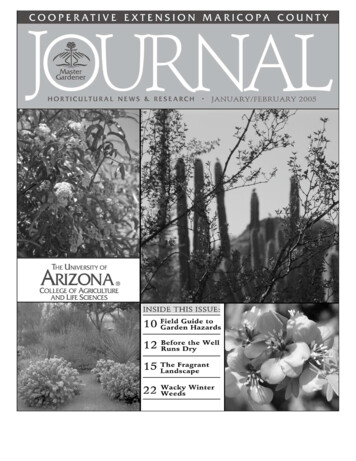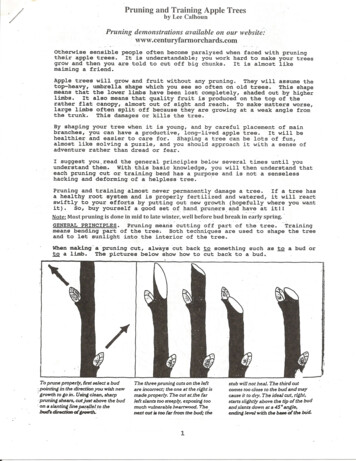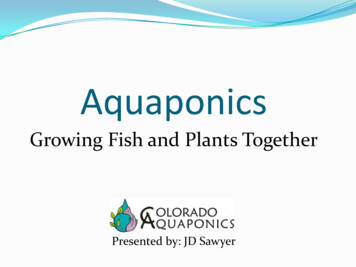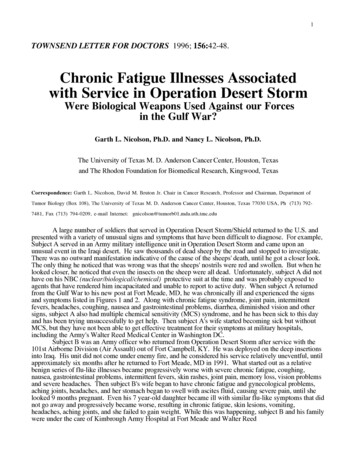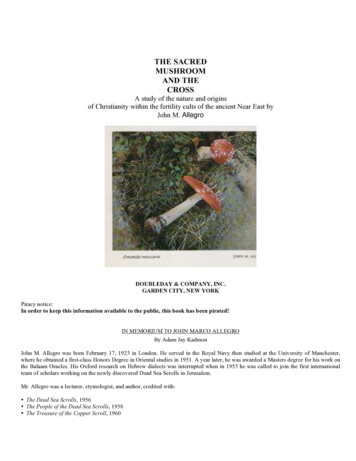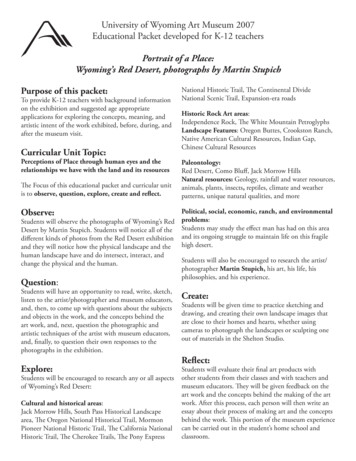
Transcription
Growing Up in theDesert: What to Eatand Where to Live2nd Grade Field Trip toRed Rock Canyon National Conservation AreaLas Vegas, NV
Growing Up in the DesertOverview:Students will make observations of plants and animals using the Red Spring Trail at Red RockCanyon National Conservation Area. They will also compare the diversity of life in differenthabitats.Duration:45-minute session for pre-activity1 day for field trip and reflection60-minute session for post-activityGrade: SecondNext Generation Science Standards:Field Trip Theme:Red Rock Canyon provides animals with the food, water, shelter, and space they need tosurvive. By learning about different animals, students can help them survive and become bettercaretakers of Red Rock Canyon.
Objectives:Students will: Know some of the plants and animals that live in the desert.Compare and contrast adaptations of at least two desert animals.Identify two habitats utilized by desert animals.Investigate and describe how animals use plants and other animals for food.Explain that habitats include food, water, shelter, and space.Explain how particular features of plants and animals help them live in differentkinds of places.Describe and compare the desert and the rainforest.Background Information:All animals no matter where they live need food, water, shelter and space in order to survive.Living in the desert is especially difficult because it is a land of extremes. The temperatures canfall below 0 F/-18 C in the winter and rise above 110 F/43 C in the summer. Water is hard tofind in the desert because it doesn’t rain very much, we only get four inches a year in Las Vegas.Without the rain the dirt or soil doesn’t have very many vitamins and nutrients to grow bigplants. The plants that do grow in the desert are usually smaller and take a long time.To survive in the desert, animal and plant species have a variety of adaptations, behavioral orphysical characteristics of a species that make it better suited to its environment.This program will explore the habitat requirements of three desert animals, each of whichbelongs to a different class, to compare and contrast the varying adaptations that enable themto continue the survival of their species. The animals to be discussed are bighorn sheep(mammals), desert tortoises (reptiles) and great horned owls (birds).Vocabulary:It is not necessary for students to know these definitions. This serves as a resource to supportstudent understanding as it comes up in discussion or activities.Adaptation: a physical or behavioral characteristic of a species that makes it more fit to exist inits environment.Aestivation: a period of dormancy during the summer that allows animals to avoid excessiveheat or drought.Brumation: the reptilian form of hibernationCamouflage: a physical adaptation that enables an organism to blend with its environment.Carnivore: an animal that eats only other animals.Desert: an arid land with usually sparse vegetation; usually receives less than 10 inches (25centimeters) of rainfall annuallyEnvironment: the circumstances and conditions surrounding an organism that influences itsexistence, including physical, biological and all other factorsHabitat: the place or environment where an organism lives and grows.
Hibernation: a period of dormancy during the winter in which the metabolic processes of ananimal are slowed.Herbivore: an animal that eats only plants.Mammal: warm blooded, vertebrate, feeds young with milk from mother, fur or hair coveredthat gives birth to live babies.Nocturnal: active only during the nightOmnivore: an animal that eats both other animals and plants.Reptile: cold blooded, vertebrate, usually egg-laying external horny scales/plates.Species: a group of organisms that have common traits or attributes.Materials: Teacher resource pages (project these images from your computer or transfer them intoa PowerPoint presentation to retain the colored graphics) Student Field Experience Journal copied for each student Here is the Southwestern Desert by Madeleine Dunphy or computer, projector, andspeakers to play the video book http://www.youtube.com/watch?v RXrOe6tOYTM The Great Kapok Tree by Lynne CherrySuggested Pre-Activity:1. Read the book Here is the Southwestern Desert by Madeleine Dunphy or play the videobook http://www.youtube.com/watch?v RXrOe6tOYTM2. Discuss the theme of the book with the students. Even though the book focusesprimarily on the plants and animals of the Sonoran Desert, many of the same plants andanimals can be found in the desert that we live in, the Mojave Desert. Show studentsthe map of the Four Major North American Deserts to point out the Sonoran, Mojave,Great Basin, and Chihuahuan.3. Show students the pictures of the geology, plants, and animals taken at Red RockCanyon, which is part of the Mojave Desert.4. Have students reflect on what they have learned in the book by filling out page 2 ofStudent Field Experience Journal.Field Trip Summary:Plants and animals play an important role at Red Rock Canyon. During this field trip, studentswill: Discuss what plants and animals of the Mojave Desert need in order to survive Observe artifacts of a desert tortoise, bighorn sheep, and great horned owl. Discuss how these animals get their basic needs from the desert. Take a tour of the Red Springs Trail to find where the tortoise, big horn sheep, and greathorned owl can find food, water, shelter, and space to survive.After coming back from the field trip, have students fill out the reflection sheet from theStudent Field Experience Journal.
Suggested Post-Activity:1. Have students reflect upon what they learned about the desert tortoise, bighorn sheep,and great horned owl. Lead a discussion on what they need in order to survive (food,water, shelter, and space).2. Have students pick an animal and draw that animal in its habitat with its basic needsnearby in their Student Field Experience Journal. Then have them describe the habitat.3. Read The Great Kapok Tree by Lynne Cherry to students. Have them draw a picture ofwhat the rainforest looks like, describe the rainforest, and compare it to the desert.
Teacher ResourcesThis page can be found in the Red Rock Canyon Junior Ranger Book Page 4 a .pdf
Show these pictures of the geology, plants, and animals at Red Rock Canyon, which is part ofthe Mojave Desert.Pictures courtesy of:http://www.redrockcanyonlv.org/photo-gallery/ ants-wildlife/
Growing Up in theDesert: What to Eatand Where to LiveStudent Field Experience JournalRed Rock Canyon National Conservation AreaLas Vegas, NVName:
Here is the Southwestern DesertThe plants and animals of the Southwestern Desert can live withoutfor a very long time.The Southwestern Desert can be broken up into smaller deserts. One of the deserts is theMojave Desert, which is where Red Rock Canyon is located. Draw a picture of what the MojaveDesert looks like using the plants and animals that your teacher showed you.
Field Trip ReflectionI took a field trip toonHere are three things I saw:Here are two things I learned:The best part of the day was:
Plants and Animals of the Mojave DesertWhat do animals of the desert need?Choose an animal from the field trip: tortoise, bighorn sheep, or great horned owl. Draw apicture that shows the animal and what it needs in order to survive.Describe the habitat of your animal. Use your picture to help you.
Draw a picture of a rainforest.Describe the rainforest. Use your picture to help you.How is the desert different from the rainforest? Write your answer in the chart.A desert has .A Rainforest has
Even though the book focuses primarily on the plants and animals of the Sonoran Desert, many of the same plants and animals can be found in the de


